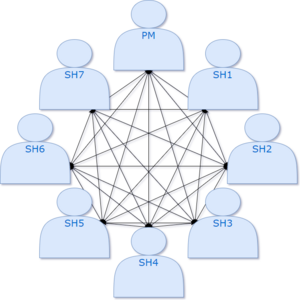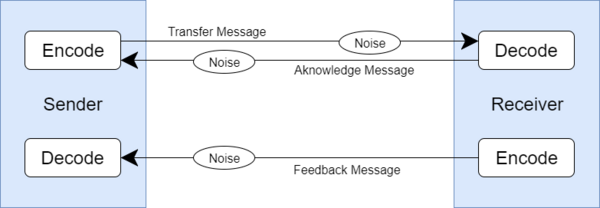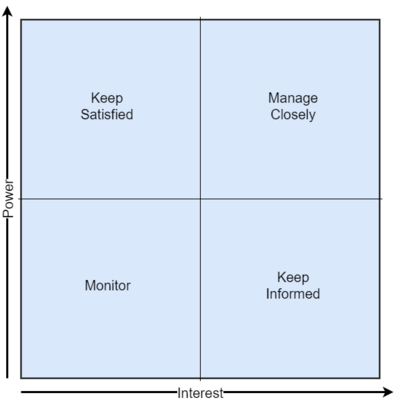Communication Management Strategy
Developed by Christian Pedersen
Contents |
Abstract

Communication is a crucial aspect of any project. A study conducted by the Project Management Institute (PMI) revealed that on average, 1 out of 5 projects are unsuccessful due to ineffective communication. [2]
One reason communication is so important, yet often times overlooked, is the complexity of a project’s communications. The total number of potential communication channels is n(n – 1)/2 where n is the number of stakeholders. This means that increasing the number of stakeholders (larger projects), greatly increases the number of channels to be considered in the Communications Management Strategy.[1]
This article explains the contents of a Communication Management Strategy in project management. The communications management strategy describes the means and the frequency of communication to parties both internal and external to the project. The strategy establishes a controlled flow of information which seeks to facilitate engagement with stakeholders.[3]
The goal of this article is to guide the reader through the process of planning communications by displaying the procedure for developing a Communications Management Strategy. The strategy is typically drafted very early, when developing the project management plan. This early planning allows for resources like time and money to be allocated to communication activities.
The communications management strategy can be a standalone document or spreadsheet, or it can be incorporated in the initial project documentation or project management tool/software. The strategy should state the communication procedure, including utilized tools, record keeping and reporting. Furthermore, it should answer the questions: When will formal communication activities take place? Who will be responsible for what aspects? Who needs what information? Where should the information be stored, and in what format? How can the information be retrieved? Other considerations such as time zones, language barriers, and cultural differences should also be considered if necessary.
Big Idea
Project Communications Management includes all the processes that are necessary to ensure that information regarding the project flows timely and appropriately. Communication takes place externally and internally amongst the project team and other project stakeholders. Stakeholders may influence the project execution or outcome, which makes effective communication an important part of project management. Project Communications Management includes the planning, managing, and controlling of communications. This article will be looking at the planning aspect, in developing a Communication Management Strategy.[1]
Planning project communications is based on stakeholder’s information needs and requirements as well as available organizational assets. The main benefit of the process is identifying and documenting the communication approach. The planning takes place in the early stages of project planning, incorporated in the project management plan. The following information should be considered when planning:
- Stakeholder Register (The output of a stakeholder analysis)
- Enterprise Environmental Factors (The organizational structure including but not limited to; location, regulation, culture, staff etc.)
- Organizational Process Assets (Processes, procedures and corporate knowledge including but not limited to; lessons learned and historical information)
The above information can be viewed as input for the planning process, whereas the Communication Management Strategy is the output.[1]
The approach to developing such a plan begins with a Communication Requirements Analysis, which determines the information needs of the project stakeholders. Communications management is closely tied to stakeholder management as both subjects deal with the flow of information, and in fact, the stakeholder analysis and resulting stakeholder register, can be considered a vital part of the Communications Management Strategy. One indicator of the projects complexity is the number of potential communication channels as shown in Figure 1. Determining and limiting these channels is a key component of the planning process. Aside from stakeholder information, communication requirements should be planned according to organizational charts as well as internal and external information needs. [1]
Different methods of transferring information should be considered when planning communication. The choice of communication technology can greatly enhance or restrict the flow of information. In some cases, conversations or meetings might be used to communicate, whereas written documents or online resources might be necessary in other cases. To select the best method, the following factors should be considered:
- What technology is available and accessible for all stakeholders?
- What is the urgency, frequency and format of the information to be communicated?
- What is the extent of learning/training required to use the technology effectively?
- What security measures should be taken in regard to sensitive or confidential information?
- What project environment considerations need to be taken? (location, language, culture etc.)
The above information can be viewed as input for the planning process, whereas the Communication Management Strategy is the output. [1]

A Communication Model may be used to describe the exchange of information. The most basic communication model consists of a sender and a receiver. To send the message, the sender first encodes the message into language. Then the message is then transmitted via a medium, to the receiver. During this phase, the message may be compromised by noise to some extent. The receiver can then decode the message and acknowledge that the message has been received. Finally, once the message has been decoded and understood by the receiver, a response can be encoded and transmitted back to the sender. It is the responsibility of the sender to ensure the message is communicated clearly and concisely and the responsibility of the receiver to understand it correctly and respond appropriately. Even in this simple example, there are many factors that can lead to miscommunication. The noise for example, can distort the message to such a degree that it is no longer useful. This could be the case in a phone conversation, where actual noise is the problem. Noise could also appear in text if has been translated or contains errors. [1]
The many methods of communication between project stakeholders can be classified in 3 categories. The categories refer to the direction of the flow of information. [1]
- Push communication refers to the distribution of information to specific recipients, where the reception and understanding of the information is not ensured. Examples include email and press releases.
- Pull communication refers to recipients accessing the information on their own accord. It is typically used for large volumes of information or for large numbers of recipients. Examples include e-learning and intranet sites.
- Interactive communication refers to an exchange of information between two or more parties. The information flow is multidirectional. Examples include meetings and phone calls.
Application
The Communication Management Strategy should begin with an introduction stating the purpose and the scope of the documentation and who is responsible for the strategy. The strategy then describes the communication methods and tools, as well as the roles and timetables. Detailed information regarding stakeholders is key for that strategy. The strategy can take a number of formats such as a document, a spreadsheet or a component in project management software. [3]
The output of the Communication Management Strategy is a plan describing the following elements:
- Stakeholder communication requirements
- Information to be communicated
- Reason for distributing that information
- Time frame and frequency for the distribution of information
- Person responsible for communicating the information
- Person responsible for authorizing the release of confidential information
- Recipients of the information
- Methods or technologies used to convey the information
- Resources for communication activities including time and budget
- Escalation process for moving issues that cannot be resolved at lower staff level
- Method for updating the Communication Management Strategy
- Glossary of common terminology
- Flow charts of the project information flow
- Communication restraints
The strategy can also include other elements relevant to project communications. The above list is suggested in the PMBOK[1] guide. Perhaps the best way to organize the strategy is by constructing a document with tables containing information methods, stakeholder information and general information needs.

Project stakeholders refer to individuals, groups or organizations that have an interest in and/or influence over the project. As mentioned previously, stakeholders are key to a well functioning communication strategy. From the stakeholder analysis, all of the stakeholders should be identified and the current and desired relationships should be known. Good communication management and stakeholder management go hand in hand. The project team must ensure that the expectations of key stakeholders are understood, acknowledged and managed As is shown in the basic stakeholder matrix on Figure 3, stakeholders are positioned on different points in the grid and should be managed accordingly. It can be advantageous to move stakeholders from one quadrant to the other. Good communication management can be effective in accomplishing this.
Furthermore, the communication needs and requirements of the stakeholders must be managed. From the analysis it should be determined exactly what information is needed by the stakeholders as well as the frequency of information. Also relevant is the communication method as newsletters or status reports may be suffice for some stakeholders, others may require interactive communication. When possible, stakeholders should be consulted about their requirements, and agreed upon the content, frequency and methods.
There are many tools that can assist with project management communications. In particular, many companies incorporate what is known as a PDM (Product Data Management) system. PDM systems are used to keep track of masses of data required in a product life cycle, or in this case, a project life cycle. The system allows for the storage and retrieval of data, allowing different users access to different data. Meta-data is used to track information about the stored data. In addition a PDM system can provide workflow management for tracking approvals and authorizations. Furthermore a PDM system may include resource scheduling and project planning in the form of a WBS work breakdown structure.
[4]
Limitations
The overall quality of the Communication Management Strategy can be assessed in that the stakeholders are managed properly. A common standard for communication has been considered. The resources required for communications have been taken into account, and the formality and frequency of communications is reasonable in regards to the project. Furthermore, the strategy should include a clear communications line and reporting structure for projects that are a part of a program. Also the corporate communications facilities such as the marketing department should be utilized where appropriate.[3]
Communication management is an ongoing process and naturally the strategy must be highly adaptable to meet the needs of the project stakeholders over time as the project evolves. Some areas of communication may need strengthening whilst others may be excessive. It is often a problem during project work to have too many meetings, where little or nothing is gained. On the other hand, a lack of information sharing can lead to time wasted if important information must be located and retrieved before work can continue. For these reasons it can be concluded that whilst the initial communications strategy is important, the ongoing maintenance and control of communications is perhaps the most essential part of communications management.
Another point that must be mentioned is the increasing prevalence of digital information. This raises many communication management issues. For one thing, all of the users of a particular software or tool must be trained in the use of the software or tool. Also the storage of the information must be considered. All important digital information should have a backup in case the original is lost. Finally the security of online information is vital. As more information is stored in the cloud, it is at risk of being accessed externally.
In conclusion it is apparent that there are many different types of projects, involving many different stakeholders. The recipe for solid communications management practices is impossible to formulate broad enough to encompass them all, yet specific enough to be relevant to a single specific project. From the project management standards we can conclude the following key points.
- Planning is everything and communications planning is no exception, so plan as detailed as possible during the project initiation planning.
- Stakeholder management has everything to do with communication. If the stakeholders are managed properly and the project team can communicate effectively internally, it is a good start.
- The adaptability of the project team is important as the strategy must be updated regularly with changes regarding what's working and what's not.
References
- ↑ 1.00 1.01 1.02 1.03 1.04 1.05 1.06 1.07 1.08 1.09 1.10 Project Management Institute. “A Guide to the Project Management Body of Knowledge (PMBOK® Guide)”- Fifth Edition, 2013
- ↑ Project Management Institute® Pulse of the ProfessionTM May 2013, The High Cost of Low Performance: The Essential Role of Communications, web:http://www.pmi.org/-/media/pmi/documents/public/pdf/learning/thought-leadership/pulse/the-essential-role-of-communications.pdf Retrieved 12 February 2018
- ↑ 3.0 3.1 3.2 ,Office of Government Commerce® , Project Management: "Managing Successful Projects with PRINCE2TM"- Fifth Edition, 2009
- ↑ Product Data Management: The Definition; An Introduction to Concepts, Benefits, and Terminology; CIMdata Inc. 1998, web:www.CIMdata.com
Annotated Bibliography
PMI® Pulse of the ProfessionTM May 2013, The High Cost of Low Performance: The Essential Role of Communications"
A report written by Project Management Institute for educational reasons. It is based on research conducted among over 700 experienced project management practitioners, over 100 executive sponsors, and over 200 business owners who have been involved in large capital projects.
Product Data Management: The Definition; An Introduction to Concepts, Benefits, and Terminology; CIMdata Inc. 1998"
An introduction to PDM systems, describing the application and terminology. Used in the course 42451 Mass Customization at DTU.